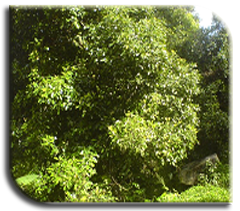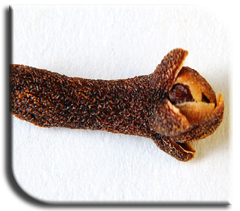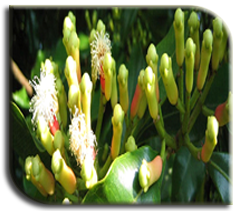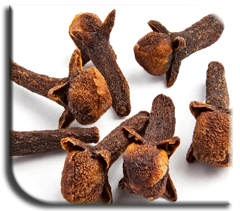Clove (Syzigium aromaticum)
Myrtaceae
 |
 |
Clove Tree |
Tree Unopen Flower Bud
(Economic Part) |
Varieties
Local cultivars are used.
Soil and climate
Humid tropical climate with an annual rainfall of 150 - 250 cm and a mean temperature range of 20°C to 30°C and elevation up to 1000 m are suitable. Deep rich loams with high humus content and laterite soils are the best suited for clove cultivation.
Season
June – December is found to be optimum.
Slopes facing South and West should be avoided. North and North-Eastern slope is preferred.
Planting
Seeds are extracted from ripe fruits and sown immediately. The seeds germinate in five to six weeks. Two year old seedlings are planted in pits of 30 cm x 30 cm x 30 cm size filled with soil and FYM 10 kg/pit at a spacing of 6 m either way. Apply 50 g/pit Azospirillum before planting.
Aftercultivation
Provide shade for seedlings. Mulch the basins with dried leaves. Weed the basins as and when necessary.
Banana can be grown to provide shade during the initial establishment. Small temporary pandals may provided for partial shade during initial establishment.
Irrigation
Frequent watering is essential in the initial stages in the absence of rains. Irrigation should be given during summer months. Applying 8 litres of water either through drip or through basin during the months of January - May is beneficial.
Manuring
One year old plants can be applied with FYM 15 kg, N 20 g, P 20 g, K 60 g in two splits during June - July and September - October. Every year the dosage is correspondingly increased and a bearing tree of 7 years old may be applied with FYM 50 kg, N 300 g, P 300 g and K 960 g. In addition to this apply 50 g in each of Azospirillum and Phosphobacterium should be applied one month after manuring.
| Time of application |
N |
P |
K |
| (g/plant) |
| I year old seedlings |
20 |
20 |
60 |
| 7 year old tree |
300 |
300 |
960 |
Plant protection
Pests
Stem Borer
Smear the surface of the stem and branches with Carbaryl 50 WP @ 2 g/lit of water.
Pour Quinalphos 25 EC @ 1 ml/lit in to the bore hole and plug it.
Apply Phorate 60g/tree in the soil
Black scale:
Foliar spray with Dimethoate 1ml/l.
Leaf eating caterpillar
Leaf eating caterpillar can be controlled by spraying Quinalphos 25 EC @ 2 ml/lit.
Leaf rot
The foliage of affected trees should be sprayed with Carbdendazim 0.1 % or a prophylactic spray with Bordeaux mixture 1 % also prevents the disease.
Leaf spot:
Pre-monsoon spray of Pseudomonas fluorescens (PfPPB) @ 0.2 % + Lawsonia leaf extracts (5 %) or Spray with Copper oxy chloride @ 0.25 %.
Quick wilt
Affected trees suddenly wilt and dried off. Prolonged drought and water stagnation affects the root growth. This is controlled by
(1) Drenching of Carbendazim or Mancozeb 1 g/lit of water in the root zone
(2) Wilting plants should be provided with shade and irrigated immediately
(3) In sloppy areas drip irrigation is recommended
(4) Dried leaves should be spread to conserve the moisture
(5) Growing of wind barriers to avoid the damages to the trees.
 |
Immature Clove Bud |
Harvest
Bearing starts from sixth year onwards. The flower buds should be harvested when they are fully mature but before opening. The buds are harvested as clusters and separated and dried in the sun for five to seven days.
 |
Dried Clove Bud |
Yield
2 - 3 kg dried buds/tree. |




